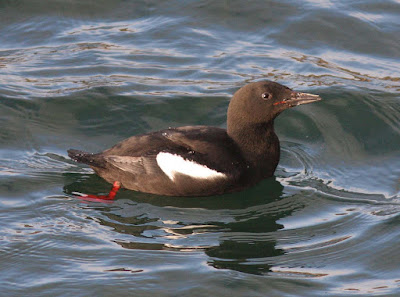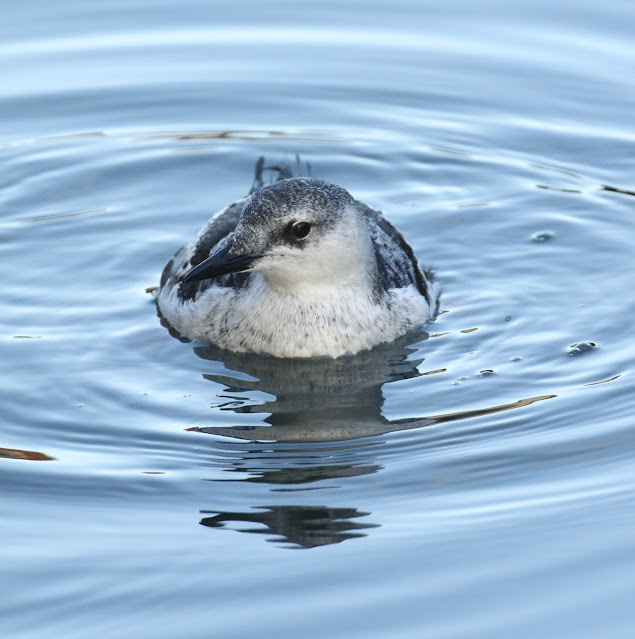A Black Guillemot has, for the last few days, taken up residence in the inner sanctum of Sovereign Harbour, at Eastbourne in East Sussex, fishing in the serene waters of what is called the Inner Harbour alongside the retaining walls, walkways and around the moored boats. This species regularly allows very close approach and shows little fear of us humans and I invariably see them very well in Lerwick Harbour in The Shetlands whenever I am there and this individual, today, currently at the other end of Britain in Sovereign Harbour, was no different.
Black Guillemots are known as Tysties in Scotland and at this time of year they are about as far from being black as possible, being an amalgamation of white, black and ashy grey of varying intensity but still retaining their crimson legs and feet, although these are maybe a shade darker than in the breeding season.In spring their plumage becomes dark brown rather than pure black, although from a distance they appear totally black with a prominent white patch on each wing
After the gloomy weather of the weekend and a forecast of sunny, calm weather for Monday I fancied a jaunt back to familiar territory in Sussex, so with my birding pal Clackers we set a course for Eastbourne. We left in the dark but the sky was dominated by the huge 'supermoon', a phenomenon manifesting itself as a huge white orb hanging low in terrifying, spherical magnificence in the western sky. Whilst driving south my mind slipped into a philosophical mood as I contemplated the Moon, something which I see almost nightly and which I take so much for granted but when thought about is almost beyond comprehension. Space, The Universe, our existence on our own planet Earth which we are destroying at an ever increasing pace was heady stuff for so early in the day. It got worse as tiredness brought on an assault of anxieties, Brexit, North Korea, Trump, Putin and all the other awfulness that comprises this world and that I can do nothing about. I chatted to Clackers to divert my mind off its downward spiral and my spirits revived as the sun rose above the approaching South Downs.
By 8.30 I had parked the car on a quiet road near the sea, in the huge maze like development that is Sovereign Harbour, a confusing complex of roads, houses, apartments and no less than four marinas which are confusingly called harbours. We walked around a building site and across some shingle towards the tidal Outer Harbour which guards the two lock gates giving access to the Inner Harbour which is the first of the marinas and then leads to the other three marinas and as we progressed I recounted to Clackers how this all used to be shingle, scrub and scattered small areas of water some thirty years ago and was called The Crumbles when I first lived in Sussex. I reminisced about finding Snow Buntings on the shingle and Scaup and Red throated Divers on the small waterfilled pits but all that is just a memory and only Langney Point now remains untouched and where it is still possible to seawatch as in days of old.
We reached the eastern edge of the Outer Harbour but could find no sign of the Black Guillemot, just a small flock of Dunlin and a lone Common Redshank stood on the gravel shoreline as we followed a pathway below towering blocks of expensive apartments and holiday homes. I recalled that last night I had seen images of the Black Guillemot that showed it to be feeding by a concrete wall and I could see something similar by the locks protecting the entrance to the Inner Harbour, which was full of moored boats including the RNLI's Lifeboat.
There was not a breath of wind this morning and sunshine beamed down albeit weakly onto the glass still sea. On reaching the locks protecting the Inner Harbour we still could not see anything but on looking further into the harbour, there, over in a distant corner by a moored yacht and next to another walkway, a small grey and white bird bobbed to the surface. Bingo!
The Black Guillemot had surfaced exactly where the pictures from yesterday had shown it to be. I pointed it out to Clackers and we walked around to where the bird was feeding, looking over the railing atop a low wall and down to where it swam, just a few feet below us. It looked up at us and then just carried on diving, submerging with the aid of its wings to propel it underwater and we could clearly see it swimming near the bottom using its wings in a penguin like rowing action under the water, searching the crevices and weed on the wall for fish, crustaceans and molluscs. It would rise to the surface every minute or so by ceasing its rowing action and allowing its natural buoyancy to lift it to the surface.
The water was still and calm, undisturbed by any craft at this early hour, so the only ripples created were from the Black Guillemot as it swam and dived amidst the multi coloured reflections of the surrounding buildings. Depending on where it was it would surface in anything from aquamarine to golden infused seawater.
It stopped feeding and had a vigorous wash, raising a welter of spray as it thrashed the water with its wings and rolled on its side to reveal a pure white breast and belly. It stood on end, treading water and flapped its narrow wings vigorously, the huge white patches on its spread wings made very evident
Black Guillemots are normally an inhabitant of rocky coasts and harbours in the north of Britain and are very rare in the south. The southernmost breeding site in Britain is Anglesey in North Wales where they breed in holes in the harbour walls and then you have to go northwest to the coast of Scotland or northeast to the coast of England at St Bees Head in Cumbria to find them again. They are also found on the coasts of The Isle of Man and Ireland.
In Sussex they are classed as a rare vagrant with only seventeen having been recorded up to the end of 2016. This year there would appear to be a slight invasion of this species as three have now been seen this winter in Sussex, this one at Eastbourne, another at Selsey Bill last week and one off Brighton Marina yesterday.
It was such a thrill to see this confiding rare visitor to Sussex floating around on the quiet waters of the Inner Harbour and so close to us. I guess the stone walls of the harbour are the next best thing to real rocks and make it feel at home. The early Monday morning winter quiet of the harbour and the lack of human activity added an almost surreal atmosphere to the whole experience.
 |
| This is an image I took of a Black Guillemot in summer plumage at Lerwick in Shetland. Markedly different to its winter plumage! |
By 8.30 I had parked the car on a quiet road near the sea, in the huge maze like development that is Sovereign Harbour, a confusing complex of roads, houses, apartments and no less than four marinas which are confusingly called harbours. We walked around a building site and across some shingle towards the tidal Outer Harbour which guards the two lock gates giving access to the Inner Harbour which is the first of the marinas and then leads to the other three marinas and as we progressed I recounted to Clackers how this all used to be shingle, scrub and scattered small areas of water some thirty years ago and was called The Crumbles when I first lived in Sussex. I reminisced about finding Snow Buntings on the shingle and Scaup and Red throated Divers on the small waterfilled pits but all that is just a memory and only Langney Point now remains untouched and where it is still possible to seawatch as in days of old.
We reached the eastern edge of the Outer Harbour but could find no sign of the Black Guillemot, just a small flock of Dunlin and a lone Common Redshank stood on the gravel shoreline as we followed a pathway below towering blocks of expensive apartments and holiday homes. I recalled that last night I had seen images of the Black Guillemot that showed it to be feeding by a concrete wall and I could see something similar by the locks protecting the entrance to the Inner Harbour, which was full of moored boats including the RNLI's Lifeboat.
 |
| Sovereign Harbour Marina with the Lifeboat and assorted vessels |
The Black Guillemot had surfaced exactly where the pictures from yesterday had shown it to be. I pointed it out to Clackers and we walked around to where the bird was feeding, looking over the railing atop a low wall and down to where it swam, just a few feet below us. It looked up at us and then just carried on diving, submerging with the aid of its wings to propel it underwater and we could clearly see it swimming near the bottom using its wings in a penguin like rowing action under the water, searching the crevices and weed on the wall for fish, crustaceans and molluscs. It would rise to the surface every minute or so by ceasing its rowing action and allowing its natural buoyancy to lift it to the surface.
The water was still and calm, undisturbed by any craft at this early hour, so the only ripples created were from the Black Guillemot as it swam and dived amidst the multi coloured reflections of the surrounding buildings. Depending on where it was it would surface in anything from aquamarine to golden infused seawater.
It stopped feeding and had a vigorous wash, raising a welter of spray as it thrashed the water with its wings and rolled on its side to reveal a pure white breast and belly. It stood on end, treading water and flapped its narrow wings vigorously, the huge white patches on its spread wings made very evident
Black Guillemots are normally an inhabitant of rocky coasts and harbours in the north of Britain and are very rare in the south. The southernmost breeding site in Britain is Anglesey in North Wales where they breed in holes in the harbour walls and then you have to go northwest to the coast of Scotland or northeast to the coast of England at St Bees Head in Cumbria to find them again. They are also found on the coasts of The Isle of Man and Ireland.
In Sussex they are classed as a rare vagrant with only seventeen having been recorded up to the end of 2016. This year there would appear to be a slight invasion of this species as three have now been seen this winter in Sussex, this one at Eastbourne, another at Selsey Bill last week and one off Brighton Marina yesterday.
It was such a thrill to see this confiding rare visitor to Sussex floating around on the quiet waters of the Inner Harbour and so close to us. I guess the stone walls of the harbour are the next best thing to real rocks and make it feel at home. The early Monday morning winter quiet of the harbour and the lack of human activity added an almost surreal atmosphere to the whole experience.























No comments:
Post a Comment